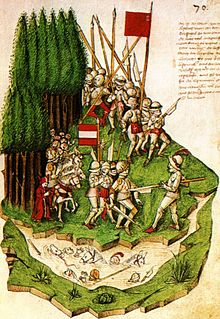- Battle of Morgarten
-
Battle of Morgarten Part of the creation of the Swiss Confederation 
Illustration from the Tschachtlanchronik of 1470Date November 15, 1315 Location Morgarten Pass Result Decisive Swiss victory Belligerents Swiss Confederation:
 Archduchy of Austria
Archduchy of AustriaCommanders and leaders Werner Stauffacher Duke Leopold I of Austria Strength 1,500 infantry and archers 5,500 infantry and 2,500 heavy cavalry The Battle of Morgarten occurred on November 15, 1315, when a Swiss Confederation force of 1,500 infantry archers ambushed a group of Austrian soldiers of the Holy Roman Empire near the Morgarten Pass. The Swiss, led by Werner Stauffacher, thoroughly defeated the Austrians, who were under the command of Duke Leopold I of Austria.
Contents
Background
The House of Habsburg coveted the area around the Gotthard Pass in order to secure this shortest passage to Italy, while the Confederates of Uri, Schwyz and Unterwalden had imperial freedom letters from former emperors granting them local autonomy within the empire.
In 1314, Duke Louis IV of Bavaria (who would become Louis IV, Holy Roman Emperor) and Frederick the Handsome, a Habsburg prince, each claimed the crown of the Holy Roman Emperor. The Confederates supported Louis IV because they feared the Habsburgs would annex their countries as Habsburg property — as they already had tried to do in the late 13th century.
War broke out over a dispute between the Confederates of Schwyz and the Habsburg-protected monastery of Einsiedeln regarding some pastures, and eventually the Confederates of Schwyz conducted a raid on the monastery.
The battle
Frederick's brother, Leopold of Austria, led an army of 3000 to 5000 men — about one third of them knights on horseback — to crush the rebellious confederates, planning a surprise attack from south via Lake Aegeri and the Morgarten pass and counting on a complete victory over the rebellious peasants.
The Confederates of Schwyz — supported by the Confederates of Uri, who feared for their autonomy, but not supported by the Confederates of Unterwalden — expected the army in the west near the village of Arth, where they had erected fortifications. A historically plausible legend tells of the Knight of Huenenberg who shot an arrow into the camp of the Confederates with the attached message "watch out on St. Otmar's day at the Morgarten".
The Confederates prepared a road-block and an ambush at a point between Lake Aegeri and Morgarten pass where the small path led between the steep slope and a swamp. When about 1500 men attacked from above with rocks, logs and halberds, the knights had no room to defend themselves and suffered a crushing defeat, while the foot soldiers in the rear fled back to the city of Zug. A chronicler described the Confederates, unfamiliar with the customs of battles between knights, as brutally butchering everything that moved and everyone unable to flee. This founded the reputation of the Confederates as barbaric, yet fierce and respectable fighters.
Aftermath
Main article: Pact of BrunnenWithin a month of the battle, in December 1315, the Confederates renewed the oath of alliance made in 1291, initiating the phase of growth of the Old Swiss Confederacy. Within forty years, cities including Lucerne, Zug, Zürich and Bern had joined the confederation.
The victory of the Confederates left them in their virtual autonomy and gave them a breathing-space of some sixty years before the next Habsburg attack resulted in the Battle of Sempach (1386).
See also
References
Categories:- 1315 in Austria
- Conflicts in 1315
- Battles involving Switzerland
- Battles involving Austria
- Battles of the Middle Ages
Wikimedia Foundation. 2010.

